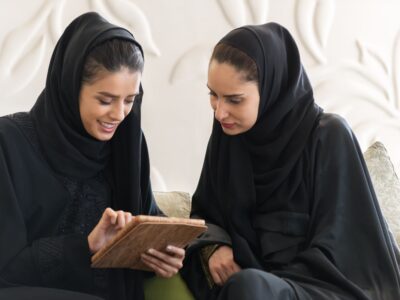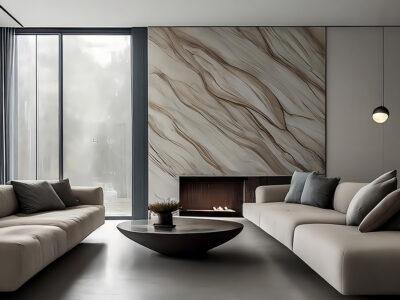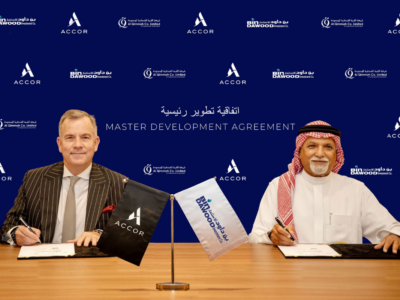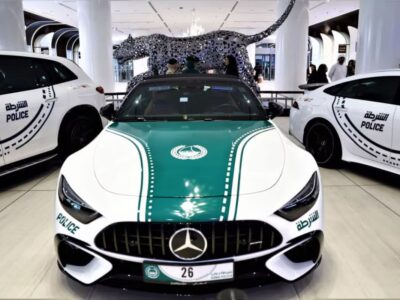In the Gulf luxury hotel sector, the last decade has witnessed a gradual swing in architectural taste away from relatively bland, boxy, largely US-influenced 1970s/’80s designs like those of the InterContinental Hotel in Abu Dhabi, the Hyatt Regency in Dubai and the Golden Tulip in Manama, for example, to a mix of more adventurous modern buildings, and retro-look, ethnically-inspired and, in particular, Arabian styles.
Dubai has been a leader in this movement.
Examples of exciting, shiny modern buildings there include the ‘upturned tuning fork’ design of the Dusit Hotel, the ‘wave’ and ‘sail’ forms of the Jumeirah Beach Hotel and Burj Al Arab respectively, the twin Emirates Towers, and the triangulated Al Bustan Rotana Hotel.
The Fairmont in Dubai is supposed to reflect the form of a giant ‘barjeel’ wind tower from Dubai, although it is arguable whether many guests actually recognise this!
1998 saw the opening of The Ritz-Carlton on Jumeirah Beach, the first UAE beach resort in modern times to have escaped from the temptation of corporate mirror glass or drab concrete render, in favour of a Californian hacienda-style, low-rise approach.
The next year saw the launch nearby of the first phase of what is now known as the One&Only Royal Mirage in Dubai, featuring another design by Wimberly Allison Tong & Goo, and the coining of the phrase ‘Arabic eclectic style’, i.e., a shameless mix of architectural influences from across the Arab-speaking world, with Nubian domes, doorways from Morocco, Moorish arches and wind towers from Dubai (which in fact were historically imported by Iranian settlers).
The Madinat Jumeirah, Bab Al Shams desert resort (both owner-operated by Jumeirah) and Park Hyatt in Dubai have all subsequently followed this same approach, and with good reason, since it successfully appeals to Gulf nationals and globe-trotting western tourists alike, as the epitome of a fairytale Arabia that never in fact existed – at least, not in Dubai.
The Kempinski-managed Emirates Palace beach hotel in Abu Dhabi is the capital’s answer to Dubai’s upwardly mobile hotel sector.
With 394 ‘seven-star’ rooms and suites, an impressive Arc de Triomphe-style entrance and 110,000m² of heather-coloured marble adorning its entire exterior, 114 domes covered in mosaic and topped with gold finials, 1002 Swarovski chandeliers and 755 plasma screen TVs, this grandiose ‘official’ property is rumoured to have cost almost US $4 billion, which if true, would make it the most expensive hotel ever built.
Elsewhere in the region, there are a number of other luxury hotels with interesting architecture.
In Riyadh, the striking Four Seasons Kingdom Centre and Rosewood Faisaliah tower hotels are locked in a design face-off across the central Olaya district.
Both towers are architecturally striking, the former with an upturned D cut-away at the top, and the Norman Foster-designed Al Faisaliah Centre boasting the three-storey Globe restaurant in a golden glass geodesic sphere at the tower summit, which as a result is typically booked out days in advance.
The Hilton and Corniche Rosewood hotels on Jeddah’s North Corniche also both boast dramatic contemporary designs.
The rather Mexican-looking Grand Hyatt in Muscat, a stone-faced beach property complete with traditional Arabian motifs, has one of the region’s most opulent interiors, the lobby featuring a rotating horseman statue, and a grand piano styled like a sports car.
The landmark, pyramid-shaped Sheraton Doha still looks modern, even after 20 years (well, the exterior does, at least).
In Cairo, the Marriott stands out from other city centre hotels in being a low-rise property, with various modern blocks ranged around a historic palace (which used to house the restaurants and function halls) in the elegant Zamalek district on the relatively peaceful Gezirah Island.
The Grand Hyatt, formerly Le Royal Meridien, is a dramatic tower hotel with a revolving restaurant on top, boasting striking views from a location on Roda Island in the middle of the Nile.
The extraordinary ziggurat—shaped Le Royal Hotel in Amman, and its pyramid-shaped sister property in Beirut, are both full of character, while Beirut remains the only Middle Eastern city to offer a selection of true boutique hotels, such as the Albergo, Four Points, Vendome and Palm Beach hotels.
It will be fascinating to see what kinds of rabbits the new generation of designer hotel brands which are entering the Middle Eastern markets can pull out of the hat.
These include the Armani Hotel at the Burj Dubai; Starwood’s W brand, debuting in Dubai and Doha; Missoni by Rezidor SAS, coming up in Kuwait and on the Palm, Jumeirah; Bab El Saray in downtown Beirut, to be designed by UK designer Gordon Campbell Gray (of One Aldwych fame) and managed by Campbell Gray Hotels; and the Kheiriddine Project in the same city, comprising three existing historic buildings beneath the Grand Serai, to be renovated under the eye of famed boutique hotel designer, Philippe Starck.
However, the next big trend in design diversification in the luxury hotel sector is sure to be seen at Dubailand, currently a vast expanse of empty desert, but planned soon to become a major global tourist destination.
Its proportions are well-known by now: at 185 hectares, covering an area twice the size of Disneyworld in Florida, it will offer 45 entertainment ‘mega projects’.
Given that Dubailand’s focus will be on themed attractions, the hotels are expected to follow suit.
For example, the centrepiece of the Aqua Dunya water theme park will be the 407m long, 400-stateroom Desert Pearl Hotel, to be operated by Jumeirah.
Billed as ‘the world’s largest cruise ship,’ the Aqua Dunya hotel will flaunt 95m high sails, towering over the theme park.
At the Falcon City of Wonders, another Dubailand theme park, there will be four hotels themed to depict well-known international landmarks: the Hanging Gardens of Babylon, the Eiffel Tower, the Taj Mahal and the Leaning Tower of Pisa.
Last but by no means least, the $27 billion Bawadi project in Dubailand has already achieved renown by proposing single-handedly to double Dubai’s existing supply, by adding 31 hotels with 29,200 rooms.
Centrepiece of the development, according to the publicity, will be the world’s largest hotel, Asia-Asia, which alone will provide 6500 rooms. (In reality, there may soon be a larger hotel in Las Vegas).
Tatweer, a member of Dubai Holding, will develop a series of 12 luxurious theme-based hotels with 16,750 rooms, with names such as the Desert Gate Hotels & Resorts, the Wahat Alkuttab Hotels, the Desert Beach Hotel & Resort, the Land of Arabia Hotels & Resorts, the Wild Wild West Hotels, the Africa World Hotels, the Europa Hotels & Resorts and the Pirate’s Cove Hotels & Resorts.
Other developers will build the rest.
Zabeel Investments has just confirmed it will build the America Hotels & Resorts.
The three-star, 500-room hotel will reportedly bring examples of New York’s famous Broadway acts to Dubai and feature a shopping boulevard modelled on New York’s 5th Avenue.
This is no doubt the first of many ‘out of the box’ concepts to be announced at Bawadi in the coming months and years.
Guy Wilkinson is a hotel industry consultant based in Dubai.
For more information, e-mail: [email protected]
The Ritz-Carlton, Dubai was the first UAE beach resort to escape the temptation of corporate mirror glass or drab concrete render







